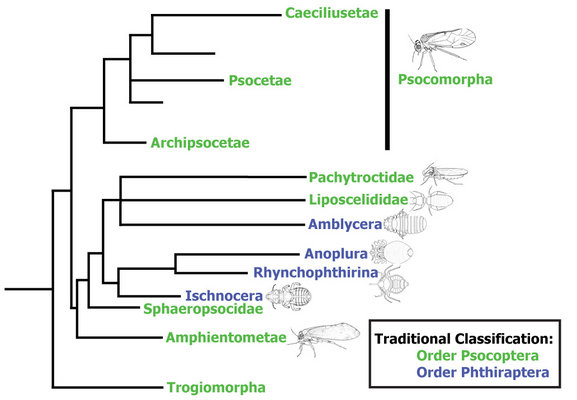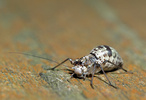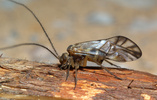Psocodea
Parasitic Lice (=Phthiraptera), Book Lice, and Bark Lice
Emilie Bess, Vince Smith, Charles Lienhard, and Kevin P. Johnson


This tree diagram shows the relationships between several groups of organisms.
The root of the current tree connects the organisms featured in this tree to their containing group and the rest of the Tree of Life. The basal branching point in the tree represents the ancestor of the other groups in the tree. This ancestor diversified over time into several descendent subgroups, which are represented as internal nodes and terminal taxa to the right.

You can click on the root to travel down the Tree of Life all the way to the root of all Life, and you can click on the names of descendent subgroups to travel up the Tree of Life all the way to individual species.
For more information on ToL tree formatting, please see Interpreting the Tree or Classification. To learn more about phylogenetic trees, please visit our Phylogenetic Biology pages.
close boxDiscussion of Phylogenetic Relationships


Summary of the phylogeny of Psocodea based on mophological (Yoshizawa & Johnson 2006) and molecular data (Johnson et al. 2004) shows evidence for paraphyly of Psocoptera. These analyses indicate that parasitic lice evolved from within the Psocoptera suborder Troctomorpha.
References
Clay, T. 1949. Some problems in the evolution of a group of ectoparasites. Evolution 3: 279-299.
Clay, T. 1951. An introduction to a classification of the avian Ischnocera (Mallophaga): Part I. Transactions of the Royal Entomological Society of London 102,2:171-195.
Clay, T. 1970. The Amblycera (Phthiraptera: Insecta). Bulletin of the British Museum of Natural History Entomology 25: 75-98.
Demastes, J. W. and M. S. Hafner 1993. Cospeciation of pocket gophers (Geomys) and their chewing lice (Geomydoecus). Journal of Mammalogy 74(3): 521-530.
Durden, L. A. and G. G. Musser 1994. The sucking lice (Insecta, Anoplura) of the world: A taxonomic checklist with records of mammalian hosts and geographic distributions. Bulletin of the British Museum of Natural History 218: 90 pp.
Hafner, M. S. and R. D. M. Page 1995. Molecular phylogenies and host-parasite cospeciation: gophers and lice as a model system. Philosophical Transactions of the Royal Society of London. Series B. 349: 77-83.
Hopkins, G. H. E. and T. Clay 1952. A checklist of the genera and species of mallophaga. London, British Museum of Natural History.
Johnson, K. P., Yoshizawa, K. and V. S. Smith. 2004. Multiple origins of parasitism in lice. Proceedings of the Royal Society of London 271: 1771-1776.
Lakshminarayana, K. V. 1986. Data book for the study of chewing lice (Phthiraptera : Insecta). Records of the Zoological Survey of India: Miscellaneous Publication, Occasional Paper 81: 1-63.
Lyal, C. H. C. 1985. A cladistic analysis and classification of trichodectid mammal lice (Phthiraptera: Ischnocera). Bulletin of the British Museum (Natural History) 51(3): 187-346.
Page, D. M., R. D. Price, et al. 1995. Phylogeny of Geomydoecus and Thomomydoecus pocket gopher lice (Phthiraptera: Trichodectidae) infered from cladistic analysis of adult and first instar morphology. Systematic Entomology 20: 129-143.
Page, R. D. M. 1994. Parallel phylogenies: Reconstructing the history of host-parasite assemblages. Cladistics 10: 155-173.
Pilgrim, R. L. C. and R. L. Palma 1982. A list of the chewing lice (Insecta: Mallophaga) from birds in New Zealand. National Museum of New Zealand Miscellaneous Series 6: 1-32.
Rothschild, M. and T. Clay (1952). Fleas, flukes & Cuckoos: A study of bird ectoparasites. Colins (New Naturalist Series).London.
Rozsa, L. 1993. Speciation patterns of ectoparasites and "straggling" lice. International Journal for Parasitiology 23(7): 859-864.
Yoshizawa, K. and K. P. Johnson. 2006. Morphology of male genitalia in lice and their relatives and phylogenetic implications. Systematic Entomology 31: 350-361.
Title Illustrations

| Scientific Name | Antarctophthirus microchir |
|---|---|
| Specimen Condition | Dead Specimen |
| Identified By | Vince Smith |
| Sex | Male |
| Life Cycle Stage | Adult |
| Copyright |
© 2006

|
| Scientific Name | Mesopsocus unipunctatus |
|---|---|
| Specimen Condition | Live Specimen |
| Identified By | K. Yoshizawa |
| Sex | Female |
| Life Cycle Stage | micropterous adult |
| View | anterolateral |
| Size | 3mm |
| Copyright | © 2006 Kazunori Yoshizawa |
| Scientific Name | Liposcelis bostrychophila |
|---|---|
| Location | Urbana, Illinois |
| Specimen Condition | Dead Specimen |
| Identified By | E. Mockford |
| Sex | Female |
| Life Cycle Stage | adult |
| Body Part | head |
| View | anterior/lateral |
| Size | 2mm body length |
| Copyright |
© 2006 Emilie Bess

|
| Scientific Name | Psococerastis sp. |
|---|---|
| Specimen Condition | Live Specimen |
| Identified By | K. Yoshizawa |
| Life Cycle Stage | adult |
| View | lateral |
| Size | 4mm |
| Copyright | © 2006 Kazunori Yoshizawa |
About This Page
Emilie Bess

Illinois Natural History Survey, Champaign, Illinois, USA
Charles Lienhard

Museum of Natural History, Geneva, Switzerland
Kevin P. Johnson

Illinois Natural History Survey, Champaign, Illinois, USA
Correspondence regarding this page should be directed to Emilie Bess at , Vince Smith at , Charles Lienhard at , and Kevin P. Johnson at
Page copyright © 2005 Emilie Bess, , Charles Lienhard, and Kevin P. Johnson
All Rights Reserved.
- Content changed 08 October 2006
Citing this page:
Bess, Emilie, Vince Smith, Charles Lienhard, and Kevin P. Johnson. 2006. Psocodea. Parasitic Lice (=Phthiraptera), Book Lice, and Bark Lice. Version 08 October 2006 (under construction). http://tolweb.org/Psocodea/8235/2006.10.08 in The Tree of Life Web Project, http://tolweb.org/










 Go to quick links
Go to quick search
Go to navigation for this section of the ToL site
Go to detailed links for the ToL site
Go to quick links
Go to quick search
Go to navigation for this section of the ToL site
Go to detailed links for the ToL site